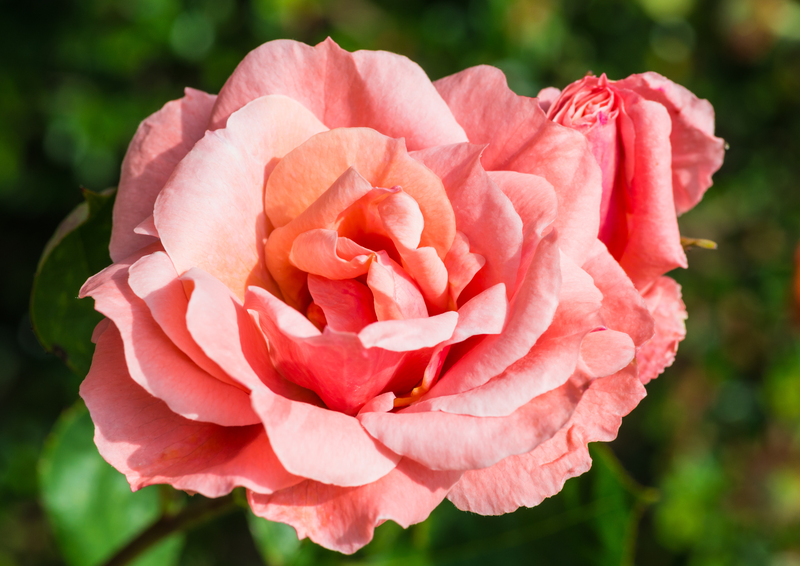Vertical Gardening: Bridging Art and Sustainability
Posted on 14/08/2025
Vertical Gardening: Bridging Art and Sustainability
In an era where urbanization is rapidly transforming landscapes, vertical gardening has emerged as a creative solution for blending art with sustainability. This innovative gardening technique is not only redefining cityscapes but also providing environmental, economic, and aesthetic value. If you're looking to maximize the potential of minimal spaces while contributing positively to the environment, vertical gardens are your perfect answer.

What is Vertical Gardening?
Vertical gardening, often referred to as living walls, green walls, or vertical plant installations, involves growing plants vertically - upwards instead of outwards. These gardens can be attached to walls, fences, or standalone structures, making them ideal for urban environments with limited horizontal space. More than just a modern gardening trend, vertical garden systems combine horticulture, landscape design, and eco-conscious engineering into a single practice.
Key Features of Vertical Gardens
- Space efficiency: Perfect for small balconies, city apartments, and office buildings.
- Aesthetic impact: Transforms bland surfaces into vibrant, living artworks.
- Eco-friendliness: Contributes to cleaner air and helps reduce a building's carbon footprint.
- Innovation: Integrates technology, art, and sustainable practices.
The Artistic Side of Vertical Gardens
Integrating nature into urban living isn't just a practical measure--it's an art form. Vertical gardening allows designers and homeowners to play with colors, textures, and patterns, bringing blank surfaces alive with living murals. From lush foliage to striking succulents, the choices are endless, making each vertical garden unique.
How Vertical Gardens Enhance Urban Art
- Expression: Vertical gardens serve as large-scale botanical canvases that showcase personal style or brand identity.
- Public Spaces: Used in museums, hotels, and city centers, they create visually stunning urban oases.
- Therapeutic Impact: Engaging with living vertical art fosters well-being and reduces stress.
Notable examples of vertical wall gardens worldwide include Patrick Blanc's iconic Musee du Quai Branly in Paris and Singapore's Supertree Grove. These installations prove that vertical gardens are far more than functional; they are expressions of creativity, culture, and environmental mindfulness.
Sustainability and Environmental Benefits
At the heart of vertical gardening lies its sustainable ethos. By harnessing vertical surfaces, these gardens offer numerous ecological advantages:
- Improved Air Quality: Plants naturally filter toxins from the air, which is especially beneficial in densely populated cities.
- Temperature Regulation: Green walls act as natural insulators, reducing urban heat and lowering energy expenses for cooling.
- Stormwater Management: Vertical plant structures help manage rainfall, reducing runoff and the risk of flooding.
- Biodiversity: These gardens provide habitats for pollinators, insects, and small urban wildlife.
Moreover, eco-vertical gardens contribute to the reduction of urban heat islands, mitigate greenhouse gas emissions, and revitalize concrete jungles by fostering sustainable ecosystems.
Vertical Gardening vs. Traditional Gardening
- Space Usage: Vertical gardens utilize otherwise-unused wall space, while traditional gardens need ample ground area.
- Water Efficiency: Smart irrigation systems in living walls can be more water-efficient than traditional landscapes.
- Maintenance: Vertical setups may require specialized care but often lead to less weed growth and easier harvesting.
Design Principles: Creating a Vertical Garden
Building an effective and beautiful vertical garden system requires thoughtful planning and a blend of horticultural skills with artistic vision. Below are essential steps and principles to consider:
1. Selecting a Suitable Location
- Lighting: Assess sunlight exposure. Vegetables and many flowering plants thrive in full sun, while ferns and mosses prefer shade.
- Surface: Walls must support the weight of the planting system, soil, and water.
2. Choosing Plants for Vertical Spaces
- Plant Selection: Choose species that suit your local climate and micro-environment. Consider using a mix of trailing vines, flowering plants, and succulents for a layered effect.
- Edibles: Herbs (basil, oregano), leafy greens, strawberries, and even tomatoes can be grown in vertical setups.
- Maintenance: Pick low-maintenance, drought-tolerant varieties if you want minimal upkeep.
3. Structural Systems for Vertical Gardens
Vertical gardens can use several modular or DIY systems, such as:
- Panel Systems: Pre-fabricated panels with slots for plants, excellent for large public installations.
- Pocket Systems: Cloth or felt pockets attached to walls, popular for home use.
- Trellises and Grids: Metal or wooden frameworks on which climbing plants can grow.
- Recycled Containers: Upcycled bottles, pallets, and gutters for creative, sustainable vertical gardens.
4. Irrigation and Drainage
- Automatic Systems: Drip irrigation ensures consistent watering and conserves water compared to manual watering.
- Drainage: Proper drainage prevents waterlogging, root rot, and wall damage.
5. Artistic Arrangement
- Color Coordination: Combine contrasting and complementary plant colors and textures for visual interest.
- Patterns & Shapes: Arrange plants in geometric or organic patterns - spirals, diagonal stripes, or gradients.
- Thematic Gardens: Create themed living walls such as Mediterranean, medicinal, or pollinator gardens.
Urban Applications: Where Vertical Gardening Shines
Cities around the world have embraced vertical gardening systems in a variety of innovative ways:
- Residential: Balconies, patios, and rooftops can become lush, food-producing spaces.
- Commercial: Restaurants, hotels, and office lobbies install green walls to boost aesthetics and indoor air quality.
- Public Infrastructure: Highway sound barriers, bus stops, and schools are integrating vertical green facades.
- Urban Farming: Vertical farms in warehouses or skyscrapers address food security challenges in population-dense cities.
Notable Examples of Urban Vertical Gardens
- CaixaForum (Madrid): A living wall by Patrick Blanc featuring over 250 plant species.
- One Central Park (Sydney): A high-rise development covered with greenery, boosting biodiversity and providing natural insulation.
- Woolworths Green Wall (Sydney): A massive facade installation that serves both as a landmark and an eco-friendly statement.
Social and Psychological Benefits of Vertical Gardening
Besides environmental advantages, the art of vertical gardening brings a wealth of social and psychological benefits:
- Enhanced Wellbeing: Interaction with greenery reduces stress, improves concentration, and supports mental health.
- Community Engagement: Vertical gardens in public spaces foster community pride and encourage sustainable behaviors.
- Workplace Productivity: Studies show that office buildings with green walls report higher employee satisfaction.
DIY Guide: How to Create Your Own Vertical Garden
Anyone can get started with vertical gardening! Here's a practical guide:
Materials You'll Need:
- Mounting structure: pallet, vertical planter, or trellis
- Pots or pockets for your chosen plants
- A potting mix suitable for your plant choices
- Irrigation supplies: bottles for DIY drip systems or commercial drip lines
- Fertilizer (organic or slow-release)
- Plants: mix of edibles and ornamentals, as desired
Step-by-Step Instructions
- Choose your wall space (indoor/outdoor) and assess sunlight and accessibility.
- Install your mounting structure, ensuring it is secure and can handle the weight.
- Fill containers with high-quality soil and arrange them according to your design.
- Plant your chosen species, following recommended spacing guidelines.
- Set up your irrigation system and test for even coverage.
- Maintain regularly: prune, fertilize, and check for pests or diseases.
With creativity and care, your wall can blossom into a stunning vertical garden that will impress friends, family, and neighbors.

Future Trends: The Evolution of Vertical Gardening
Vertical gardening technology continues to evolve rapidly, influencing how cities interact with nature. Exciting advancements include:
- Green Architecture: Buildings are now being designed from the outset to incorporate integrated living walls for energy conservation and air purification.
- Smart Vertical Systems: Automated sensors monitor plant health, optimize irrigation, and adjust lighting for maximum growth and sustainability.
- Biophilic Design: Urban planning increasingly relies on green infrastructure that connects occupants with the natural world.
The role of vertical gardening in sustainable environments is only set to grow as more communities recognize the value of blending environmental stewardship with urban artistry.
Conclusion: Bridging Art With Eco-Consciousness
Vertical gardening is more than a horticultural practice--it is a movement that bridges the gap between art and sustainability. By transforming bare surfaces into lush, vibrant ecosystems, living walls are revolutionizing design, urban planning, and environmental conservation. They inspire us to reimagine our cities, homes, and workplaces as living canvases that not only delight the senses but also support the planet.
If you want to contribute to a greener, healthier, and more beautiful world, vertical gardening offers a practical, artistic, and sustainable way forward. Whether you dream of a flourishing salad wall in your kitchen or wish to green up your office lobby, now is the time to get creative and embrace the power of living walls.
- Embrace creativity through vertical plant arrangements
- Reduce your carbon footprint with eco-friendly green walls
- Inspire urban transformation by showcasing sustainable landscapes
Start your vertical gardening journey today and be part of a movement that's changing our view of gardens--and our cities--forever!

